It is very much ALIVE! (Blake steps on Soap Box)
I recently read an article titled “Is the Death of HDR Coming?”. Where I read it is not necessarily important to point out. I would prefer to allow the source and author to remain credible, as they are, and not be discredited by what you read here. However, this article is just plain silly! While I understand the gist of it there are a couple things that might confuse the beginner photographer who may have an interest in the HDR photography process.
In a nutshell the article is saying that the death of tone mapping and/or HDR Software may be coming based on the high levels of dynamic range contained in a single raw file but that is very different than the death of HDR. Tone mapping is a sub category of HDR, I will get into this later. First, let’s have a history lesson in HDR.
The History of HDR
HDR Photography is nothing new by any stretch of the imagination. As a matter of fact it is nearly 165 years old… it is very much like a vampire! The earliest forms of HDR date back to the 1850’s with Gustave Le Gray. In an effort to extract as mush luminance from a scene as possible, he took 2 exposures. One for the ocean and one for the sky and manually blended them in the darkroom. You can read more about it here.
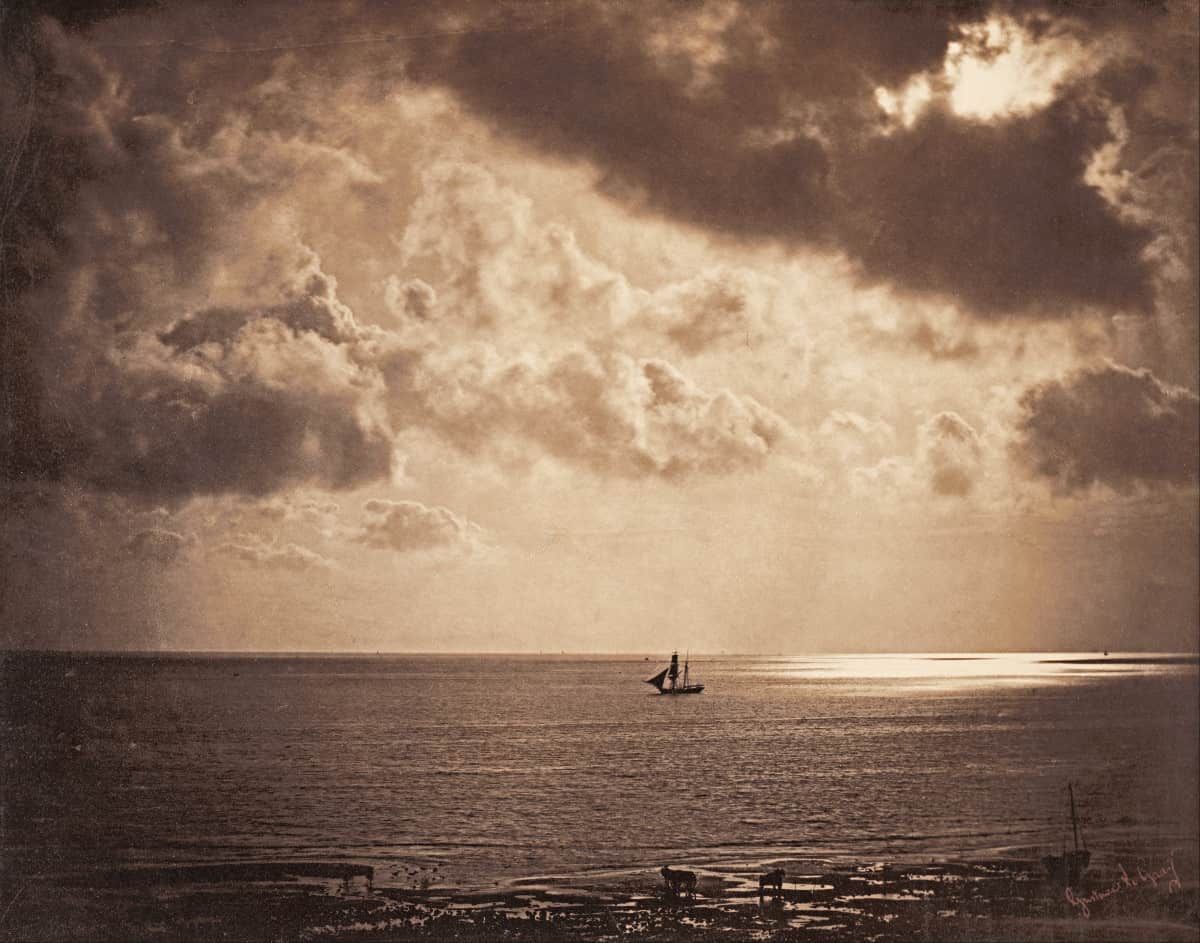
“Gustave Le Gray – Brig upon the Water – Google Art Project” by Gustave Le Gray – dwEJBbTOxE61pQ at Google Cultural Institute, zoom level maximum. Licensed under Public Domain via Wikimedia Commons – http://commons.wikimedia.org/wiki/File:Gustave_Le_Gray_-_Brig_upon_the_Water_-_Google_Art_Project.jpg#/media/File:Gustave_Le_Gray_-_Brig_upon_the_Water_-_Google_Art_Project.jpg
Fast forward to the mid 1900’s to the man I pay the most tribute to and often call the father of HDR photography, Ansel Adams. He took the idea of luminance to an extreme with his teachings about the Zone System, which if you have not read the book The Negative, I highly advise it. Adams used multiple exposures and dodging and burning to exploit as much dynamic range from a scene as possible. This, much like Gustave’s method, required multiple exposures to blend in the dark room. This was a labor intensive process that would need yield instantaneous results like we have today.
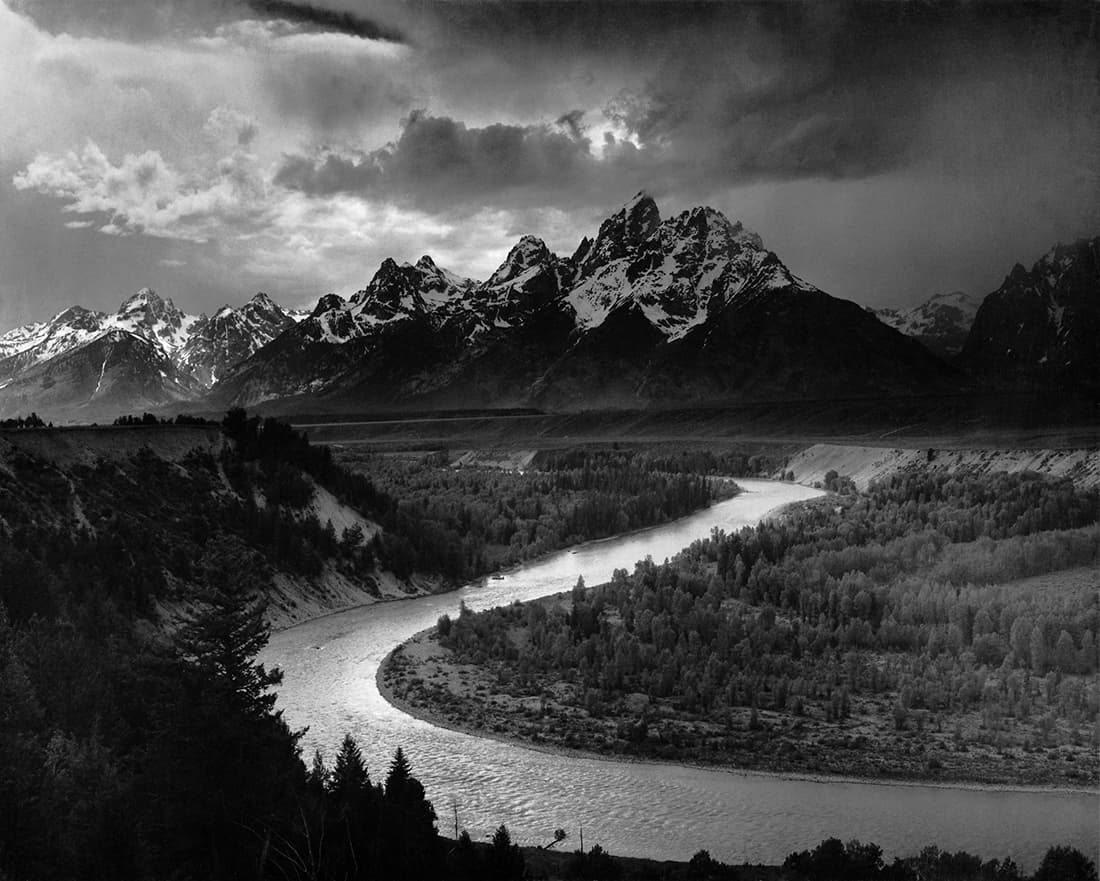
“Adams The Tetons and the Snake River” by Ansel Adams – http://www.archives.gov/media_desk/press_kits/picturing_the_century_photo_gallery/tetons_snake_river.jpg (hi-res)This media is available in the holdings of the National Archives and Records Administration, cataloged under the ARC Identifier (National Archives Identifier) 519904. Licensed under Public Domain via Wikimedia Commons – http://commons.wikimedia.org/wiki/File:Adams_The_Tetons_and_the_Snake_River.jpg#/media/File:Adams_The_Tetons_and_the_Snake_River.jpg
And here we are in the early 2000’s and we are seeing conversations about the possible death of “HDR”. Sure there are a lot of ways to make an HDR image now and newer image sensors yield some amazing dynamic range depth in a single raw file. But to say that is going to kill HDR is silly, it may negate one of the methods used to make an HDR image, but it will not be the death of the HDR process.
To fully understand this we must first breakdown the term HDR and discuss some of the methods.
What is meant by HDR?
Simply put HDR, or High Dynamic Range, is nothing more than a technique (or series of techniques) used to heighten the dynamic range in a photograph. Dynamic Range, in photographic terms, is the ratio between the lightest and darkest intensities in a photograph. Our eyes are capable of seeing a very wide spread of dynamic range where photographic image sensors are restricted to one instance, until you exploit the RAW file that is!
Many people use HDR techniques to achieve a heightened sense of reality in a photo. There are many techniques one can use to create an HDR image and some produce better results than others. However, even those who reject the HDR techniques because of their ability to make disgustingly cartoon like images may be engaging in HDR practices without even being aware of it!
HDR Techniques
There are several techniques one can use to create a ‘HDR’ image. For the sake of breaking down barriers, let’s call this dynamic range exploitation. Forget the term HDR for a bit. The main goal with all of these techniques is to exploit the amount of dynamic range in a given scene to make the photograph more appealing. Here I will be discussing 3 ways, but in the recent course Exploring HDR: The Video Series I discuss 6.
1. Tone Mapping
This is the most traditional method when we hear the term HDR we typically think of tone mapping. With this process one would take multiple exposures of the scene, usually between 3 and 7. The range is variable but most commonly there are one to two stops of light between each exposure. This allows for an underexposed image, properly exposed image, and over exposed image. The exposures are then brought into something like Photomatix Pro and combined to make one photo with the best (or sometimes worst if not used correctly) of all three worlds.
The resulting image still requires some work to make it a great photo. It is wise to consider any tone mapped image as a working negative (like film photography). It needs some time in the digital darkroom to make it better.
|
Advantages |
Disadvantages |
| Can create fantastic results | Can create horrid results if not used correctly |
| Output to 16 Bit TIFF (lots of data there) | Large 16 Bit TIFF’s, the bigger the megapixel the bigger the TIFF |
| You will have multiple exposures on hand | Requires more than one exposure for best results |
| Requires more work in post processing |
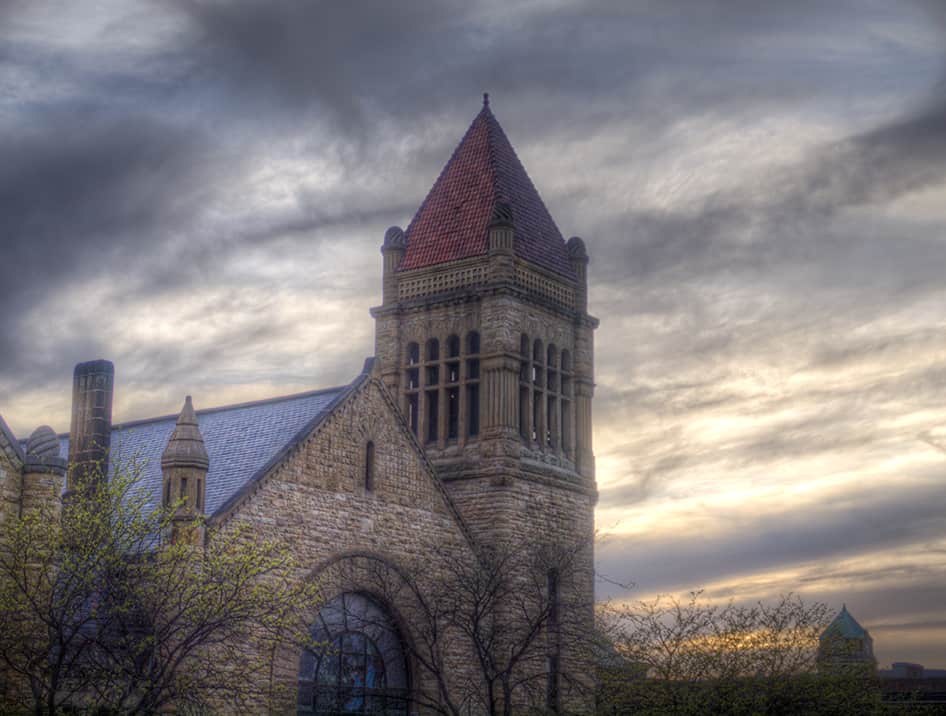
After Tone Mapping. No Post Processing work done. Needs more work to be a ‘Finished Image’.
2. Multiple Exposure Blending
This process requires the use of multiple exposures. Just like the examples in our history lesson of Gustave Le Gray and Ansel Adams. To achieve this style of HDR image one would expose for the foreground and expose for the background. This would be for scenes with a large amount of dynamic range in them, i.e. a sunset, sunrise, shooting toward the sun, etc.
This process would require software that allows you to use layers, like Photoshop. For our example here, a selection will be made for the sky in the sky exposed image and placed onto the image exposed for the church.
|
Advantages |
Disadvantages |
| Creates very natural looking results | Must have layering software |
| Can often be done even with one exposure processed twice in ACR or Lr | Must be highly proficient with layering |
| Can alleviate the tone mapping step | Can be very time consuming |
| Some areas may be impossible to select (hair, trees, etc) |
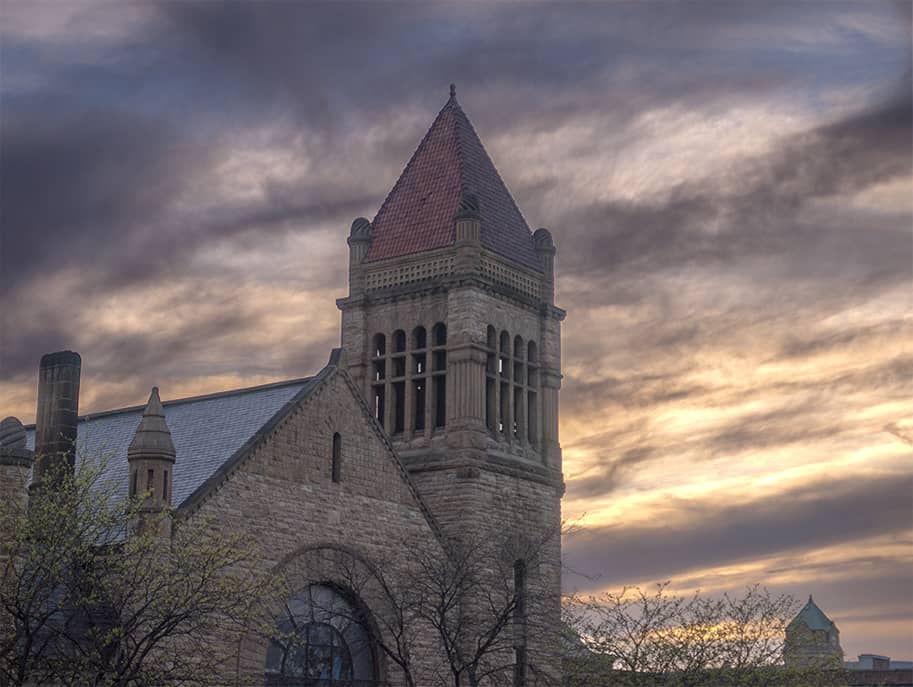
Multiple Exposure Blending, still requires more work in post, but a good start.
3. Single Exposure
This process uses one single RAW exposure to exploit the amount of dynamic range contained in a single RAW file. Many photographers use this technique in their everyday workflow but disregard it as being ‘HDR’. In years past this was referred to as Pseudo HDR when the intent to call the image HDR was still prevalent. As time has progressed this method has gained acceptance among the masses and is often not even referred to as ‘HDR’.
The article I referred to in the introduction to this reaction post was all about using this method. As image sensors advance, the RAW files they produce contain higher levels of Dynamic Range. This allows you to exploit more detail and dynamic range from the image. Typically this is done using the Shadows, Highlights, Whites, and Blacks adjustments in Lightroom or Adobe Camera Raw. Any movement of the 4 adjustments mentioned here produces a heightened dynamic range in the image. It is considered HDR but not considered tone mapping.
| Advantages |
Disadvantages |
| Can efficiently produce great results | An acceptable amount of dynamic range in the RAW file must be present |
| Do not need multiple exposures if the exposure was correct | May have clipped highlights or shadows |
| Can create natural results that do not appear tone mapped | Must know how to operate ACR or Lightroom well |
| Can create high levels of noise in dark areas of the original exposure |
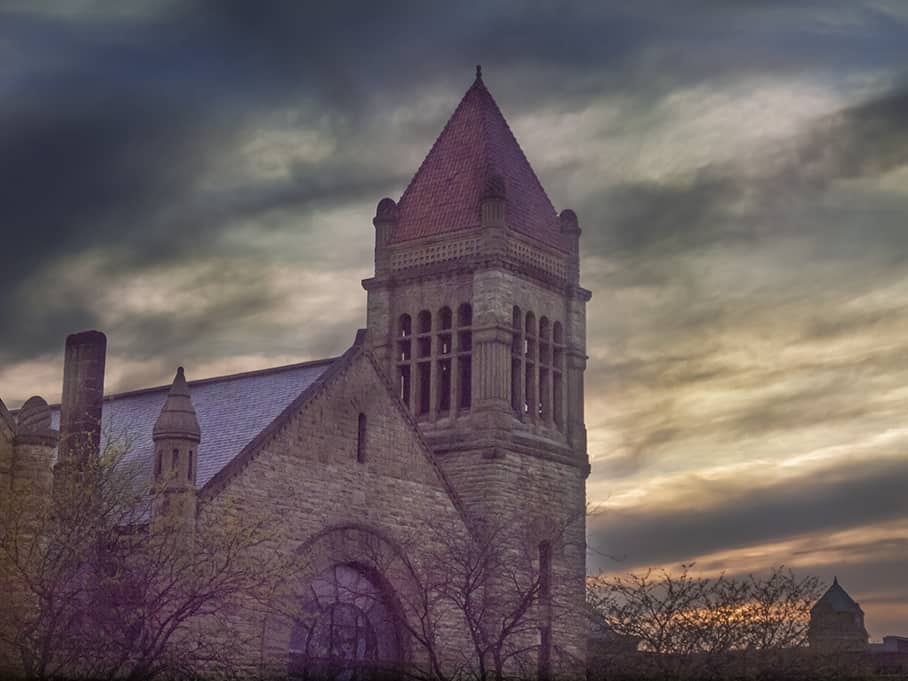
Single Exposure HDR from a 12 Megapixel camera Raw file with limited dynamic range compared to today’s sensors. It is very possible to achieve even better results from a newer camera such as a Sony a7r, a7II, Canon 6D, or even the Sony a6000.
So, is HDR Dead or even dying for that matter?
Absolutely not! As long as their are adjustments to control Highlights and Shadows HDR will not die. With the advent of better and better image sensors on the rise, the way we edit our photos will be an ever evolving process. We may be using less and less tone mapping and more single exposure processing but that is still a form of HDR.
For me, the tone mapping process is still very prevalent in my workflow. Based on how I post process my images I rely heavily on a solid low contrast 16 bit TIFF as it contains a lot more bit depth than a 14 bit RAW file. In the same breath, since owning the Canon 6D and Sony a6000 I do see myself processing more single exposure HDR images in a pinch.
In conclusion, I don’t see this as being the death of HDR or the HDR process. I do see it as the death of those three letters in front of a photo. Many people hear ‘HDR’ and immediately think ‘tone mapped crap’. However, that is very much false. There are many ways to process a photo to achieve a heightened dynamic range and those who discredit ‘HDR’ because they saw one or two poorly tone mapped images may in fact be drinking the HDR Kool-Aid without even knowing it!









I am surprised how many experts teach the single exposure HDR technic. In my tests, a 3-shot series created from a single image (-2, 0, +2) yields at most a .75 EV increase in dynamic range. (Images vary but .75 is about all you can pull form a single raw image) Considering the 30% rule, the benefits gained from .75 EV are little more than barely visible.
I know what you mean. I don’t care too much for the extraction of exposures from a single RAW file. I have shown it several times because it has been requested, but I see the most benefit from the Single Exposure in Camera Raw.
Not necessarily using that single image to tone map, but to just exploit the DR in the single Raw that is already there. If the exposure is a strong 0 EV exposure that is not too dark or too light (no histogram clipping) it is incredible just how much can be squeezed out of it. Even without tone mapping or creating multiple images.
I have used the single exposure technique rarely only when 1) it’s not really practical to attempt multiple exposures and 2) the image really does have a very good base exposure and the RAW file was created on a very modern sensor with lots of latitude contained in the data, and finally 3) the image is good enough to warrant this because the ability to get a sharper, less noisy negative, trumps the disadvantages of extra time and trouble. For me, it’s one of those tools in your arsenal that is good to know about because it can save you some headaches when the situation happens to call for it and you have the confidence to call upon it.
Great article Blake! I see articles bashing “HDR” from time to time, and they dont have to do too much work to prove their point – HDR makes photos look like clown vomit. Like I always have to remind myself, its not the bow and arrow, its the Indian shooting it.
I agree w/ you 100% – RAPABYVA all the way!
HAHA! RAPABYVA will live on! Why wouldnt’ anyone want Really Awesome Photos About Blowing Your Viewer Away?
I see more HDR bashing than i care to! However, after 5 years of running an HDR blog and this is the first time I have ever had to write an article like this!
I like the bow and arrow comment, it is also very similar to the “Guns Don’t Kill People, People Kill People”
“HDR doesn’t kill photography, Photographers kill photography”!
I came to HDR photography after watching a video with Bill Fourtney shootng Olympic National Park using HDR techniques for some of his shots. The result he got were amazing. HDR dying??? Don’t think so.
I think choosing the right HDR process for each specific photo is critcal, there is so much information to process. I have studied and applied techniques from your Exploring HDR video series. I have found that chosing the wrong one and it can get real ugly , real quick. Chose the right one and the results are stunning, and can not be achieved by any other means. There is nothing like HDR done well.
Thanks for injecting some reality into a controversial subject.
You are on point, Ed! It is all about choosing the correct HDR method for the image, which is sometimes easier said than done!
Nice, Blake. You make a great apologetic for the techniques that have evolved over the decades to give us better artistic vision for what is seen and felt through our senses if light and space. And even tone-mapping, technically, can never go away completely as long as the camera and software need to convert images from one bit density to another. That’s what’s happening in firmware or software every time we see a preview of a RAW or high-bit image. The display can’t actually perform a direct visual preview, so it tone maps a preview for us.
The question should have been worded differently by the original author: will better programmable cameras let most of the tone mapping be done in camera rather than with the user doing it manually (even picking presets is a manual adjustment in a way). And of course the answer would be that, yes, as a way of delegating routine, less important decisions to more automated and intelligent electronics, we are then freed to do even more incredible and creative work with the images we find most important or valuable. I think that with technology, the choices always seem to expand, not contract. The HDR palate is much wider than it was 10 years ago when I first began exploring the tone mapping tools of the day.
Final thought: HDR via bracketing is really a kind of compositing, which is specialized in its purpose. I don’t see compositing going away, but becoming more interesting and fluid in the application. What’s happening more and more is that photographers are thinking more purposefully about which brackets and how many and how spread apart they are, and I can see the cameras and software coming to the aid of the photographer in ways that have not yet been brought to bear. It would be cool to have an application/light meter in a camera or portable device that could accurately configure the brackets and number of brackets to capture the best detail and noiseless contrast of a scene in real time, maybe even one that could be manipulated by the user to preselect based on a desired outcome or style, depending on the user’s preference regarding shadows or highlights or midtones or moving objects. I think we’re only scratching the surface at this point. We haven’t begun to exhaust the possibilities.
I agree 100%, the title was misleading. Probably so to obtain more views and entice readership.
I would love to see an intuitive camera that could readout the appropriate amount of brackets based on the dynamic range of the scene. That would be incredible! There are occasions where I shoot more than three brackets… not often, but occasionally. However, it takes a trained eye and a series of failures to come to that realization.
You are correct, we are only scratching the surface, this is the tip of the iceberg for sure!
Hi Jeff,my comment is awaiting moderation,but I would love to see what you think of my method when it comes up.It has a lot to do with what you have written…:-)
There is actually a workaround for bracketing on Canon’s. On my 5D Mark II I use a third party firmware called Magic Lantern. It is awesome for HDR photography! In it’s auto mode you set your base exposure and it calculates how many brackets you need and fires away. It works quite well. I use live view and the live histogram in conjunction with it and I have been really happy with the results.
Ooooh I need this magic lantern!
I like to experiment with different ways of getting to the same result.
After doing a little homework on “hidden” menu items with regard to my 70D I found they have an “exposure lock”function.This immediately got me thinking about what the most important(in most cases)criteria was for a credible dynamic image.For me burned highlights are a sin and I fixed this by using live view and the “live Histogram” function.I would use spot metering to expose for the brightest part of the image and then “lock” the exposure.I would then fire off 7 brackets with the “0” exposure officially my darkest exposure(no blown highlights).This gives me a “0” to +6 range(using 1ev spacing).Depending on the dynamic range of the image,which is sometimes extreme,I adjust the size of the steps to compensate ie I usually only space at 1 ev.This gives the smoothest gradients and gets rid of any halo problems completely.But given that not all scenes are the same,some being very dynamically challenging,I would space them at say 1 1/3 ev to push the range even more,getting it to as close to the +8 max of my camera.This usually takes care of most scenes as far as dynamic range is concerned.Hope this adds something to the HDR pool 🙂
Hmm, that’s interesting. I’ll have to try that. I usually meter for my midtones at 0ev that makes them zone 5, then those midtones become zone 3 and 7 over a 2 ev spread. I’ve had great success with that, but well try your method also.